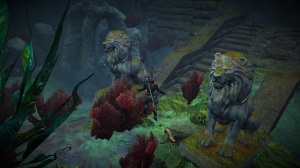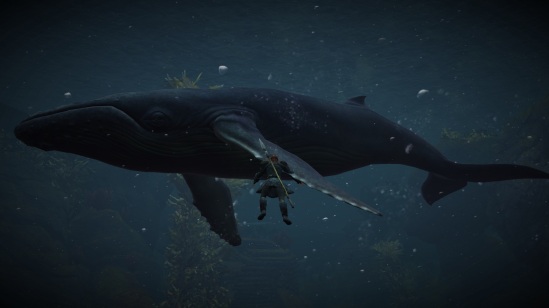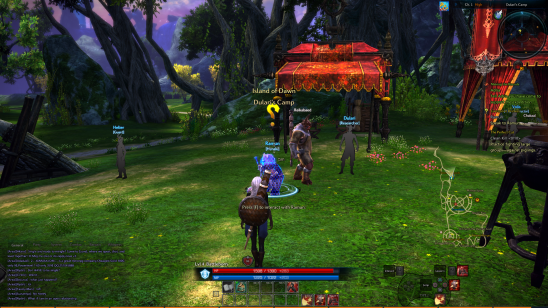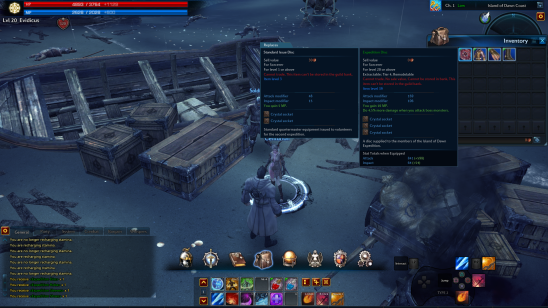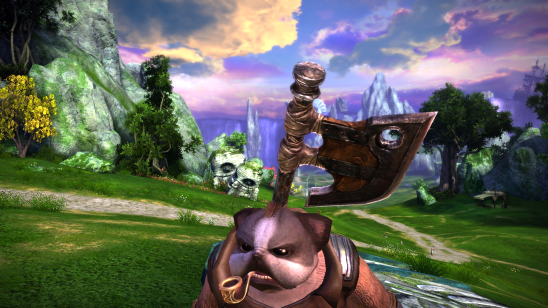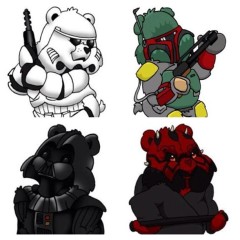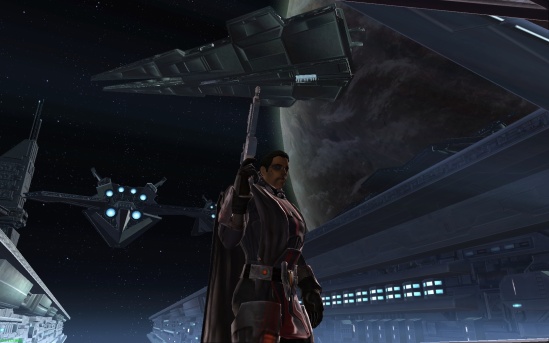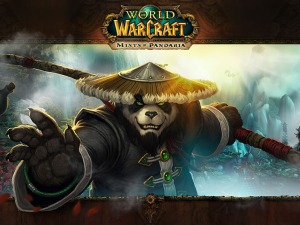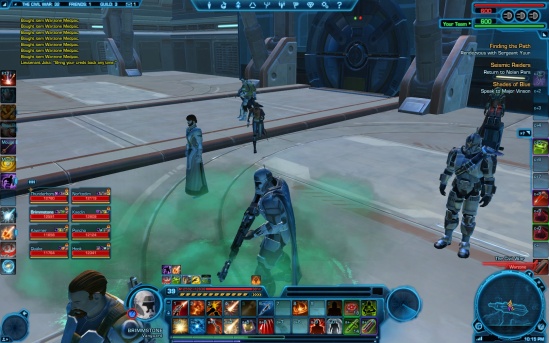I have had a few discussions recently involving the usefulness of the Holy Trinity in MMO design, and whether or not a move away from it is the next step in MMO evolution. In this article, I’ll speak of what I refer to as “Traditional MMOs”. MMOs in this category are those including World of Warcraft, Star Wars: The Old Republic and other similar titles where the Trinity exists. While these titles are certainly successful, they represent old design that makes for static, UI driven combat which brings people together out of co-dependence rather than interdependence. (More on that later.)
Let’s begin with what exactly the phrase Holy Trinity means.
WHAT IS THE HOLY TRINITY?
The Holy Trinity in MMOs refers to three basic and traditional roles that every single character falls into:
1. Tank – A high health, highly damage resistant player who has the sole focus of getting and maintaining the attention of enemies and withstanding the punishment they dish out. The idea is that the demon/dragon/giant enemy crab would kill anyone else in a single blow, but the Tank survives because his or her gear, class and skills/talents are all focused on mitigating or avoiding enough of it to take a few hits. They’re the masochists of the MMO genre, and pride themselves on being able to take a punch. Every fight revolves around the same concept for tanks… “How can I put myself in harm’s way?”
If you’ve ever watched the original Rocky, then you’ve seen a perfect example of a tank.
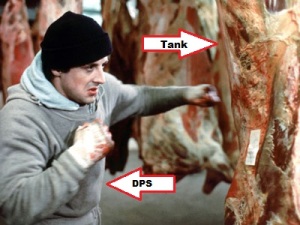
Meat Shield
While it may surprise you as to which one in the picture I’ve given the title to, the reason for this is pretty simple: tanks aren’t really good for much other than this one, highly specific job. Dedicated tanks often romanticize their role, (I’ve been guilty of it) and there can be aspects of tanking that are dynamic and require precision and timing. At the end of the day however, the boss is a German Shepard, and the tank is a hotdog stuffed inside a chew toy. In a traditional MMO only 1 or 2 players per group are tanks, depending on group size, for this very reason.
2. DPS – Stands for “Damage Per Second” – a basic measurement for how much pain you can dish out over the course of a fight. The higher the number, the better you are at video games and the more attractive you are to members of the opposite sex. The acronym also stands for the people who will make up the majority of your group in a traditional MMO. They are the sadists of the MMO genre. They can be split into melee or ranged DPS, but generally share common traits of being egotistical, completely self-absorbed and dedicated to one thing and one thing only – their own damage output relative to everyone else around them. And by everything else I mean their own survival, the survival of those around them, or even if the enemy you’re fighting dies or not. All of it is secondary. They may possess some utility abilities as well (like being able to crowd control enemies and prevent them for hurting other players), but since there are no meters to track the numerical significance of such things, they generally don’t do them unless tasked to do so. If they die, someone else is generally to blame. If the group fails, it is because of a weak link elsewhere in the chain (and they have the combat log numbers to prove it). DPS players are the least important members of the Trinity, yet suffer from the deepest delusions of self-importance. Certainly there are exceptions to this mindset, but not many.
The fact remains, however, that the only reason DPS is important is because (in most traditional MMO boss encounters) there are artificially imposed fail conditions called “enrage timers” that are put into place to prevent groups from stacking enough tanks and healers to slowly defeat the boss without much effort. Unless you have enough DPS in your group, the boss finally has enough of you, gets bored and finally obliterates you for willingly entering its lair. How he is suddenly only now able to do this requires a suspension of disbelief that good encounter designers must stay up all night thinking about, searching for ways to logically weave the reason into the story. Mediocre designers on the other hand, just don’t give a shit.
Need an example of DPS? Say hello to Clubber Lang.

"My Prediction? Pain."
3. Healer – Last, but certainly not least, we have the healer. If tanks are masochists, and DPS are sadists, then healers are the enablers of traditional MMOs. The reason I list them last is because without the other two, they really have no purpose. They only exist to ensure others can live to do their jobs, and their role is to make sure that no one else has to suffer the consequences of standing in front of a boss and intentionally taking damage, or blindly wandering into areas containing fire, acid, poison or any manner of deadly hazards.

"I TOLD him not to fight. I was OOM!"
They are highly specialized players, like tanks, only their specialization is to sit back and essentially play a separate mini-game from everyone else. This game is usually played by mousing over draining health bars and making them fill up again by pressing different buttons depending on how much of the bar they need to fill and how much available time they have to fill it. The skill of this game centers on managing a limited healing resource – like mana – in order to fuel your heals. This game is generally the same, offering only slight variations in the background location it’s played in, and regardless of the complexity of the encounter everyone else is participating in. In fact, I’d wager anyone with some rudimentary programming skills could make a downloadable app for the iOS called “MMO HEALER!” that simulated this easily enough without costing $15 a month to play.
Good healers will be there for you no matter how reckless you are, or how many times you blame them for your own stupid mistakes. If you’re lucky, they won’t even say “I told you so” and remind you how they told you NOT to pull the next pack of mobs until they were at full mana. Typically you only bring the bare minimum number of healers needed to keep everyone alive since they tend to nag a lot and wear silly red hats.
So… what’s the problem? Obviously the Holy Trinity works. Ten million WoW players can’t be wrong.
- It forces people to depend on each other because no one can survive alone, at least not on challenging and interesting content. Isn’t playing together the whole point of MMOs? In that regard, I’d say the Trinity certainly has a lot going for it. Everyone needs someone else.
- Everyone knows what their job is. It allows specialization to the point of exclusion of all else. You can excel at one aspect of the Trinity and be hailed as a great and powerful slayer of pixels. People in traditional MMOs are constantly looking for quality tanks and healers to group with. You’re a walking commodity! What’s not cool about that?
- It reduces loot drama. Hybridization aside, most gear that drops in traditional MMOs is so specific to one of the Trinity’s roles, it all may as well be as color coded as the Mass Effect 3 endings.
- It makes content easier to design and execute. The existence of the Trinity means that content is formulaic, even in the most complex of encounters. Encounter designers can assume up front that you’ll have x number of tanks, y number of healers and z number of DPS. Then it just becomes a matter of figuring out the correct method to balance the encounter to those numbers. Someone is always supposed to have aggro. Someone else is supposed to heal. Everyone else is supposed to kill the boss. It’s familiar, and it means every fight can be approached in essentially the same way.
WHAT’S WRONG WITH THE HOLY TRINITY?
Short version: It is stale. It is predictable. It makes content formulaic. It centers on playing the UI and not the game. And it brings people together out of co-dependency instead of interdependency.
Allow me to expand on that a bit.
Familiarity can be a good thing. As my friend Emmet summarized, developers stick with the Trinity because “there is no risk of spending millions of dollars over several years to create a system that is either intrinsically broken or is so unfamiliar to the gamers that you do not succeed”. But familiarity ofter breeds contempt as well. The Trinity isn’t broken, but we’ll never really push the MMO genre forward unless we’re unafraid to take risks. Status quo design leads to stale gameplay and games that are just new versions of ones we’ve all played before.
The same formulaic content that makes group content easy to approach in Trinity games also makes them boring. We live in an era of gaming where boss strategies can be found as fast as you can alt-tab out to a website. Sure, it takes execution to succeed, but it is still essentially paint by numbers. The top 1% of players will kill a boss, the strategies will find their way online, and the remaining 99% just follow it step by step. The very knowledge that you’ll have a set number of tanks, healers and DPS each and every time means encounters have to fall within certain parameters that are predictable. Furthermore, once you defeat the boss the first time and it gets placed on “farm status”, it just becomes a repetitive task. It is static content. I could still log into WoW right now and defeat content based almost entirely on memory.
As far as the UI differences go between games that are built around the Holy Trinity and those that aren’t, I have an entire article about it already on the site . The short version is that games that are based around the Trinity end up being experiences where you play the UI instead of the game. This is especially true for healers. Your screen is not only cluttered with a myriad of different abilities – most of which are situational but that you need on hand in case that one situation pops up – but you also need meters and bars and mods to support your gameplay. Below is an example of what I mean. Grid is a powerful addon for WoW, but it is often the only thing many healers stare at during encounters. This is your game. Everything else going on around you is just scenery. Sometimes that scenery may kill you if you’re not looking, but that’s what peripheral vision and other mods are for.
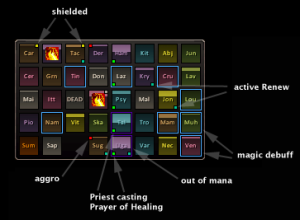
Image from Mystic Chicanery
So what is with all the psychological references about dependency?
The idea about this article was rolling around in the back of my head, and I just happened to be listening to the Tales of Tyria podcast on the way to work one morning. (ToT is an excellent Guild Wars 2 podcast! Check your local listings.) During this particular episode, at around the 18:30 mark they began discussing a PC Gamer article in which author Chris Thursten asked developers at ArenaNet about Guild Wars 2 and its departure from using the Holy Trinity. In the article, and during the podcast, questions arose regarding teamwork vs dependency and co-dependence vs interdependence. I realized these kinds of themes really helped me put my ideas into context, and how I see it is this…
Co-dependence is relying on others to provide what we are not providing for ourselves.
In traditional MMOs, this is exactly what the Trinity is designed to do. We can’t fully provide for ourselves. Just sit in any city or population hub in a traditional MMO and look at general chat. Try to find a dungeon group as a DPS player. How long do you typically wait? How many times do you see phrases like “Looking for Tank” or “Need Heals” scroll by your text window? The level of specialization offered by the Trinity comes at a price.
Even in player versus player combat, the team with the best healers generally wins. You can get by without a tank just fine (although depending on the MMO and the type of battleground you’re in, a tank can be a big benefit), but fighting without healers is suicide. It gets to a point that controlling and neutralizing the enemy healers becomes the main objective instead of the actual objective the game expects you to focus on.
In fact, in any traditional MMO, you will reach a point that the game becomes unplayable unless you have the right balance of the Trinity represented. That is co-dependence. The other real downside is that once you fill your needed tanking and healing roles, you don’t really need more. It limits your ability to play with the people you want to play with unless they also happen to fill the appropriate role you happen to need. You may hear phrases like “Bring the player, not the class”, but that only gets you so far in a Trinity game.
Independence is being self-reliant and completely capable of providing for your own needs.
In an MMO setting, this is solo play. It’s just you, and maybe a pet or non-player companion, against the world.
This is also what champions of the Holy Trinity rally against and cite as an example of what threatens to make MMOs who stray from it bland and homogenized. After all, if you can do everything, then why do you need other people? It’s a fair point, and one that needs to be explored as more and more MMOs become more solo-friendly. I consider this fear to be unfounded, however, given the other ways we have to differentiate ourselves from other players in different game genres. I think the article quote from ArenaNet developer Jon Peters says it best when he’s talking about shooters like Team Fortress 2. “No-one would tell you that everyone in Team Fortress just does damage,” he says. “No-one would say a Spy and a Heavy are the same because they both do damage – they’re very different playstyles. They have a very good sense of purpose.”
The incentive to group with people shouldn’t be limited to a cost-benefit analysis of the specific buffs they bring or role they fill inside the Trinity. You can remain independent and fully capable and not have that automatically mean you’re a loner or a carbon copy of everyone else around you. In fact, a group of independent people can still come together and become greater than the sum of their parts. Which brings us to…
Interdependence – The synergistic combination of multiple self-reliant people who provide for the needs of the whole.
Taking a queue from Jon, and drawing upon my own recent experience with Tribes: Ascend, I can honestly say there is no way I feel a team in Capture The Flag feels homogenized. I can fill every role as a Technician. I can guard our flag, capture the enemy flag, chase down enemy runners, provide support for our runners, and guard and repair our team’s generator and base defenses. I may be better suited towards generator defense, and there are reasons Technicians excel at it, but I can be just as brutally effective in other ways on the battlefield. On the other hand, I can decide to play a Doombringer or a Pathfinder and have a very different playing experience within the same game even though we’re all similarly equipped with guns and jetpacks. I can choose to do it, but I don’t have to. And even if I stick with my Technician across 20 games in a row, I can end up with 20 different experiences based on what roles my team has covered and what they need most when I join. It is my willingness and ability to adapt to the situation, and that same willingness and ability in others around me, that makes us a team.
That is interdependence, and that is why it is superior to co-dependence.
And that’s why there is not only life after the Holy Trinity, but why better and more dynamic MMO experiences are on the horizon.
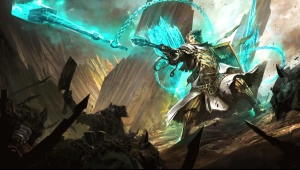
OUT WITH THE OLD. IN WITH THE NEW.
So how can we play in a MMO without dedicated tanks and healers? ArenaNet hopes to answer that question with Guild Wars 2 when it launches later this year.
In Guild Wars 2, each of the eight classes are designed to be interdependent. Everyone has the ability to self-heal, and you can heal others with proximity and ground targeted abilities. The lack of direct target healing means you can play the same game as your friends without the need to stare at health bars. Everyone can tank based upon proximity to the mob you’re fighting, but not for long. Tank swapping is something you’ll work together with everyone to do, like a pack of wolves taking down dangerous prey. To top it off, everyone can put out respectable damage while supporting the group as a whole. The specialization and customization comes from how you want to perform these roles and which you’d prefer to focus on most.
You leave Tank, Healer and DPS behind and you move on to Control, Support and Damage.
CONTROL isn’t a totally new concept to MMOs, but the emphasis placed on it in Guild Wars 2 will be a step forward. Most damage in the game is avoidable. You can dodge out of it or control your opponents in such a way as to negate their ability to harm you. This is something new for people coming from WoW or SW:TOR, and it can seem like a bitter pill to swallow for people who love healing and tanking in those games. The good news for these players is they can still be just as valuable. It just requires a new mindset.
I liken it it to a dilemma I recently had. For an upcoming Pathfinder game, my friends and I were all currently deciding which classes to play. No one wanted to be stuck with the healer. It can be a gratifying role, but it is more of a necessary evil than anything. In researching classes, I discovered an article about playing a Wizard in which the author stated that dedicated healers aren’t useful in combat because they are reactive instead of proactive.
He states that, “The Wizard will alter reality to prevent damage, a healer will try to do damage control after the damage has been taken. The mechanics of the game make preventing damage more efficient then healing damage after the fact. That’s not to say a well placed heal never has use in combat – but if you’re doing your job – it should never be required as a primary role.”
In Guild Wars 2, there are all sorts of ways to control your enemies via conditions. You can blind, cripple, fear, bleed, knockdown, daze, immobilize, push, pull and even confuse your enemy – which actually makes your enemy take damage if they use an ability. Tanks and healers can now look to become controllers who prevent damage and dictate what enemies do (and to whom) by use of positioning and conditions. If you want to center your class build around control through liberal use of conditions, you can easily do so.
SUPPORT is the other way you can gain the upper hand on your opponents and boost the effectiveness of your allies. Again, it isn’t a new concept, but it is cranked up to eleven in Guild Wars 2. It isn’t about providing a few class specific buffs before the fight, but rather giving your allies boons they can benefit from in the middle of the action. You can boost their damage output, critical strike rating, health regeneration, movement speed, ability to sustain damage and even make it so enemies take damage if they attack them.
You can also support your allies through interesting skill and talent choices unlike anything I’ve seen in other MMOs. For example, it is possible to build a Thief who every time he uses his Steal ability will poison and weaken his opponent while buffing his nearby allies with increased damage, critical strike rating and movement speed. Furthermore, every time he uses a poison utility skill, the poison will apply to his allies’ weapons as well. It is just one of several ways you can build out a thief, but the fact that you can take a class that isn’t traditionally known for being supportive and have it fill a heavy support role is impressive.
DAMAGE is still very much the same old role, but now everyone can do it. No one has to feel like they need to respec or grab a friend in order to walk around in the open world and be able to hold their own. You can still specialize in damage output, but you have to realize up front that your survival is primarily your own responsibility. Glass cannons won’t have anyone else to blame if they die.
The end result is that combat and content can be much more dynamic. Tanking and spanking won’t cut it. Everyone needs to adapt to situations that can change in a much more fluid way, and no one can afford to get complacent because no one is safe. You can play with your friends regardless of their class and tackle anything the game throws at you as long as you are skilled enough to defeat it.
Only time will tell if ArenaNet’s gamble will pay off, but I have a feeling that its very existence will be enough to bring much needed change to the MMO genre.
If you’d like to delve even deeper into the subject, here are a few resources that can help:
There is an awesome video by WoodenPotatoes that covers the lack of Holy Trinity in Guild Wars 2.
A great article by MesmerPL highlights the transition from Holy Trinity to the Control, Support and Damage model of Guild Wars 2.
Finally, Guild Wars Insider has a page that details all of the conditions and boons present in Guild Wars 2, so you can get a clearer picture of how these all work.


